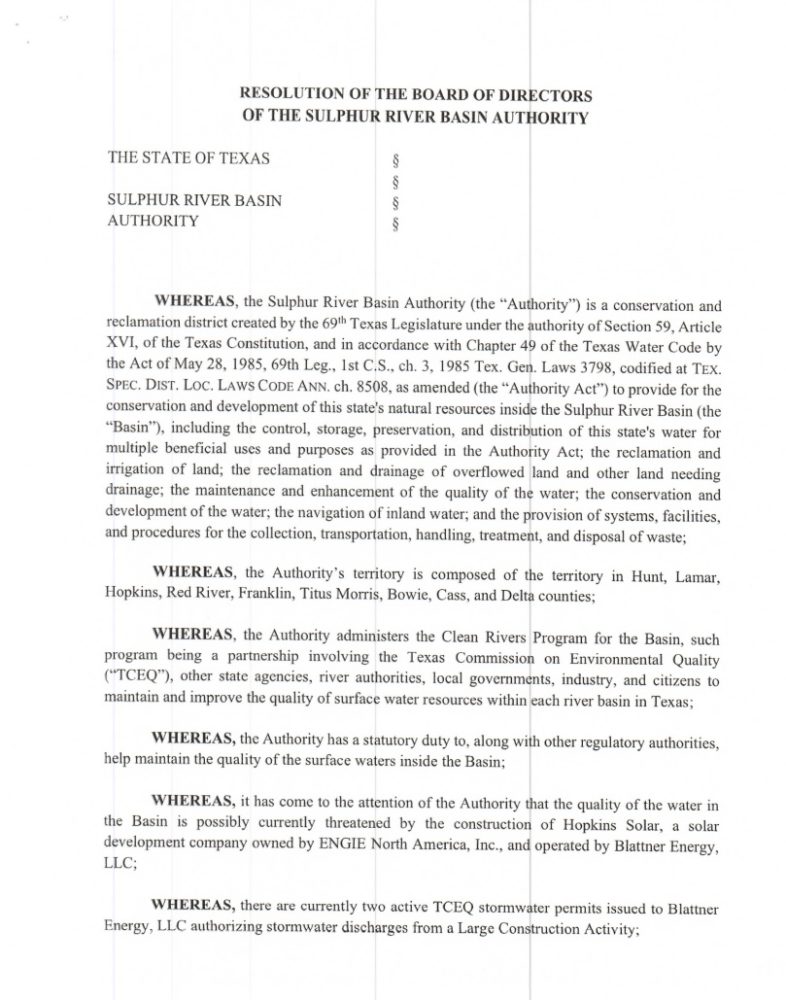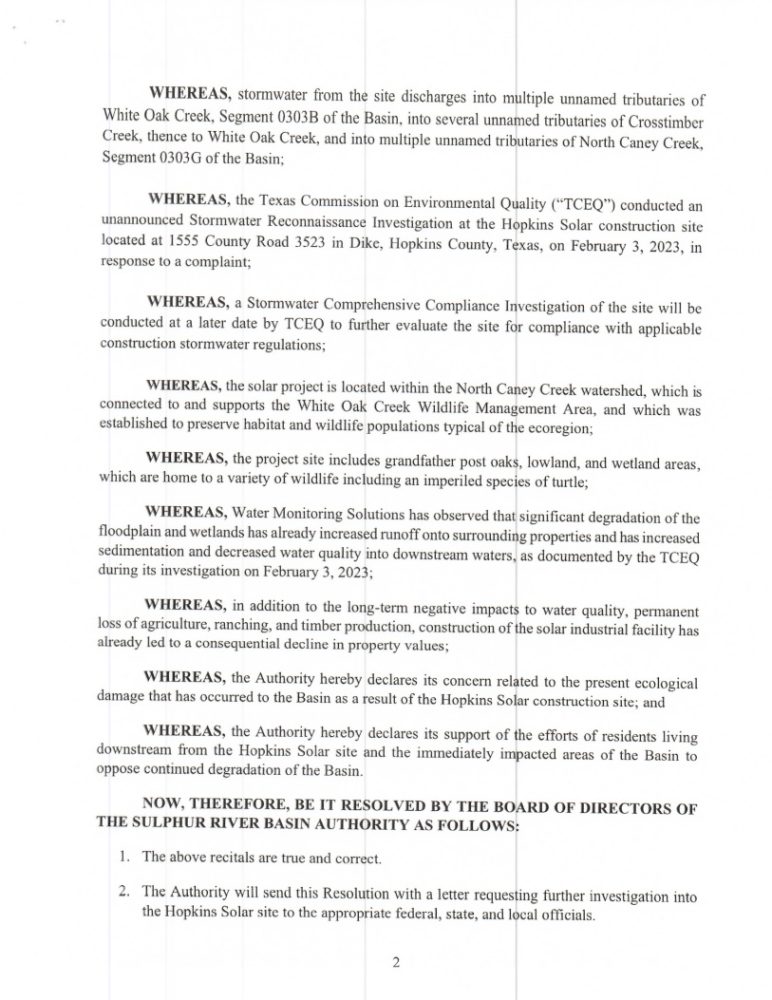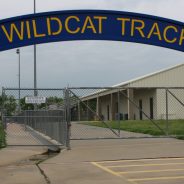Lady Cats Track & Field sending five plus a relay team to Area meet

Coach Ross Hicks and his team had a solid outing Tuesday and Wednesday, Apr. 11-12 at Liberty Eylau’s Harris Field for the 15-4A District meet, as Sulphur Springs sends five athletes and a relay team to the next level.
“Overall, it was a good day,” the track and field coach said Thursday morning.
One of two Lady Cats to qualify for an event at the Area meet is Jaicee Jasmer. Her efforts in the 200 M dash got her fourth place at a time of 26.92. Finishing top four allows the Sulphur Springs athlete to qualify for Area. Jasmer, however, really shined in pole vault. The sophomore’s 10’6″ winning mark made her the first of two Lady Cats to win an event at the 15-4A district championship.
Amerson Boles also moves on in pole vault, placing fourth at 9′.
The 800 M dash sees two Sulphur Springs athletes qualify for Area:
- 3rd. Abbey Williams — 2:32.97
- 4th. Laney Hurst — 2:34.81
Rainey Johnson narrowly missed out on placing coming in five seconds after Hurst in fifth.
1600 M run saw Edith Martinez come in second place, at 5:44.93 and getting eight points in the process for Sulphur Springs. The Lady Cat then went and emerged victorious in the 3200 M run, crossing the finish line with a winning mark of 12:49.61.
Dylan McKinney missed out on qualifying the 1600 in fifth and Williams got sixth in the 3200. Coach Hicks said McKinney was in the fourth the entire race but was edged out in the final steps by a Paris runner, losing out on the final qualifying spot by 0.15 seconds.
And the 4×200 M relay team of Rowan Faircloth, Trinity Jefferson, Codee Roland & Jasmer moves on to the Area round as the Lady Cat squad got fourth in the event.
Sulphur Springs athletes not previously mentioned scoring points over the two day district championship at Liberty Eylau were
- Jaden Allen, 110 M hurdles — 19.31 (5th)
- Madison Jeter, 300 M hurdles — 53.72 (6th)
- Trinity Jefferson, High Jump — 4’8″ (5th)
The first two aforementioned Lady Cats are freshman and competing at a high level at the District championship, an experience that Coach Ross Hicks believes is crucial for the development of Sulphur Springs track and field.
The relay team of Aaliyah Cheatum, Hurst, Johnson and Jolea Moore came up fifth in the 4×400 M relay crossing the line at 4:21.57. While missing out on the Area meet, Tuesday’s outing is a season best time for the Lady Cats.
In the 4x100s, Jaicee Jasmer, Jefferson, Roland, and Vanessa Wayne got 6th.
Cumulating 69.5 points, Lady Cat track and field finished fourth at the 15-4A meet.
Coach Hicks liked what he saw from his team over the two day meet held at Harris Field in Texarkana.
“Nearly all of them had a season-best here at district, so we’re peaking at the right time. And I truly think that peak will continue through Area and they’re gonna be ready to roll in Paris next week.”
Next up, the track and field coach and five of his athletes plus a relay team move on to the Area meet scheduled to be held in Paris on Thursday, Apr. 20.

KSST is proud to be the official Wildcat and Lady Cat Station. We broadcast Sulphur Springs ISD games year round live on radio. When allowed, we also broadcast games via our YouTube channel.
Let’s Get Kids Into Gardening
By David Wall, Mount Pleasant Master Gardener
When I was in 4th grade, Mother decided I should have a garden. She picked a spot shaded in mornings, and said, “Have at it!” Well, a fourth grader trying to get bare ground with no gloves or tools didn’t do a very good job. I did manage to plant some carrots so thick they looked like weeds. So, I pulled the weeds, which ended my early gardening efforts! Needless to say, it was MANY years later before I felt a true calling to be a gardener.
Many adults who garden would like to instill a similar desire in their children, grandchildren and great grandchildren. The goal is to instill a strong desire without inducing a quick burnout. Outsourcing weeding and maintenance to youngsters for your existing garden can quickly induce burnout, possibly on the first day! Rather, they need simple tasks that have a quick feeling of success.
Perhaps assigning them one to a few plants and showing them what to do. You might let them closely observe whatever you’re doing whatever with many or a row of plants before having the do the same to their assigned plants, all under your close supervision, never scolding, but correcting and encouraging. Letting the water a few plants after watching you first. Don’t forget to turn the sprinkler on them from time to time! Your objective is to make it fun rather than hard work.
Then, there’s watching you prune several plants before (gulp, choke, sweat) allowing them to do the same. Most importantly, show them how to pick vegetables. While you may see considerable pride at any of their efforts, you’ll really see pride when they pick vegetables from THEIR plants. Come fall, they may want to take some veggies to school and discuss what THEY did in THEIR garden!!!

Paris District Road Report for April 17, 2023
Paris — Here’s a look at work planned in the district for the week starting April 17, 2023. These schedules are subject to change due to weather conditions, equipment failure or other unforeseen issues. Motorists are advised to remain alert and pay special attention to all signs, barricades and traffic controls, and reduce their speed as they approach and travel through work zones. They should also avoid distractions such as cell phones, eating, drinking, or car audio or navigation systems.
Sherman Area (Fannin, Grayson Counties)
Contacts: Sherman Area Office (903) 892-6529; Grayson Co. Maintenance (903) 893-8831; Fannin Co. Maintenance (903) 583-7566.
US 75, Grayson County: from FM 1417 to SH 91 (Texoma Parkway). Watch for shoulder closures and lane shifts on the northbound and southbound US 75 main lanes between SH 91 and FM 1417 as crews work on building new main lanes, bridges, and retaining walls. Watch for lane closures on the frontage roads between FM 1417 and SH 91. A reduced speed limit of 60 mph on the US 75 mainlanes has been set for this construction project.
The eastbound entrance ramp to US 82 at the US 75 intersection is closed to traffic. This ramp serves as the entrance ramp to eastbound US 82 at US 75. This closure is needed to complete the construction of the US 82 eastbound Frontage Road and new entrance ramp. Motorists are advised to use the eastbound frontage road and continue east through the Loy Lake intersection and use the eastbound entrance ramp from Loy Lake Road to gain access to US 82.
The eastbound US 82 exit ramp to US 75 is temporarily closed in order for crews to make the connection of the new exit ramp to US 82 and the frontage roads. Motorists traveling eastbound on US 82 are advised to use the FM 131 / Travis Street exit (Exit 641) and follow the eastbound frontage road to access US 75.
The northbound and southbound US 75 frontage road intersections with Center Street have been converted to an all-way stop. Traffic on the frontage roads is asked to pay attention to the advanced warning signs and new stop signs, and approach the intersection prepared for a stop there.
Lamar Street and Houston Street under US 75 are closed to through traffic with detour signs in place to guide motorists around these intersections.
Eastbound Lamar Street traffic will turn right on the southbound US 75 frontage road, turn left on Center Street, and turn left on the northbound US 75 frontage road to return to eastbound Lamar Street. Video animation of this detour can be seen at the following link.
https://youtu.be/5LrCpdOA8OQ
Westbound Houston Street traffic will turn right on the northbound US 75 frontage road, turn left on Washington Street, and turn left on the southbound US 75 frontage road to return to westbound Houston Street. Video animation of this detour can be seen at the following link.
https://youtu.be/7jCatnI3Oq4
These switches will allow crews to reconstruct the proposed US 75 mainlanes and the bridge over Lamar and Houston Streets. The US 75 northbound frontage road traffic is reduced to one travel lane, but two travel lanes remain for northbound US 75 mainlane traffic. A concrete barrier separates the northbound frontage road and mainlane traffic. Video animation of this alignment can be seen at the following link.
https://youtu.be/y_uO0UmpCzk
For southbound US 75 the frontage road traffic is reduced to one travel lane, but two travel lanes remain for southbound US 75 mainlane traffic. A concrete barrier separates the southbound frontage road and mainlane traffic. Video animation of this alignment can be seen at the following link.
https://youtu.be/k2EG2W9rFJY
US 75, Grayson County: at the US 82 intersection. Watch for shoulder closures on the northbound and southbound US 75 main lanes between South Loy Lake Road and Lamberth Street as crews work on building new exit and entrance ramps. Watch for shoulder closures and lane shifts on the eastbound and westbound US 82 main lanes between FM 131 and Loy Lake Road while crews work on building new exit and entrance ramps. Watch for lane closures and lane shifts for the frontage roads at the US 75 and US 82 intersection as crews work on construction of new frontage road lanes.
FM 1417, Grayson County: from US 82 to SH 56. Watch for lane shifts and shoulder closures between US 82 and SH 56 while crews construct the new roadway pavement. The ultimate roadway will be a four-lane divided section with turn lanes. A reduced speed limit of 45 mph has been set for this construction project. The West Cypress Grove Road intersection on the east side of FM 1417 is closed to through traffic to allow crews to work on paving at the intersection. During the closure, traffic wishing to use Cypress Grove Road is asked to use Mimosa Drive and Redbud Trail as a detour route. Mainlane traffic has been switched to the new concrete section between Lamberth Street and SH 56. The intersection of Taylor Street on the west side of FM 1417 is closed to traffic in order for crews to complete the reconstruction of this intersection. During the closure, traffic wishing to use Taylor Street is asked to use Lamberth Street and Little Lane as a detour route. The Taylor Street closure is expected to last three weeks, weather permitting.
SH 11, Grayson County: from FM 697 in Sherman to US 69 in Whitewright. Work on the pavement overlay project has begun. Watch for daytime lane closures as workers mill and then overlay the roadway with a hot-mix surface. Motorists should expect delays as flaggers and pilot cars direct traffic through the work zone.
Park Road 20 in Eisenhower State Park, Grayson County. Watch for daytime lane closures within Eisenhower State Park as workers perform base repairs on the roadway and then overlay the roadway with a hot-mix surface. Motorists should expect delays as flaggers and pilot cars direct traffic through the work zone.
US 82, Grayson County: from the Cooke County line to FM 131 in Sherman. Watch for lane closures as workers replace the bridge railing and guardrail approaches at each bridge structure and install median barrier. During construction, the bridge location will be reduced to one lane while crews replace the bridge railing.
US 82, Grayson County: at the Old Southmayd Road intersection. Watch for daytime lane closures as workers lengthen the existing left turn lanes on US 82 at the Old Southmayd Road intersection and add right-turn lanes.
SH 56 (Main Street), Grayson County: in Whitesboro from Union Street to Collinsville Street. Watch for daytime lane closures on SH 56 as crews work on the rehabilitation project to remove and replace the sidewalks and parking areas along the square. During construction, the front entrances to the buildings will be temporarily closed and customers are asked to enter from the rear entrances. Occasional road closures will be required with a detour route in place to guide motorists around the project. The detour route will guide traffic along Union Street, Thode Street, and Collinsville Street to get around the project.
South Travis Street, Grayson County: in Sherman at Post Oak Creek. Construction is underway for the replacement of the South Travis Street bridge over Post Oak Creek. During construction, the bridge will be reduced to one lane with traffic signals controlling traffic through the project, while the new bridge is built in phases.
Business US 377B, Grayson County: south of Whitesboro at the railroad underpass near US 377. Watch for lane closures with signals controlling traffic while crews work to upgrade the bridge railing.
US 75 full depth concrete repair, Grayson County: Crews will be working on US 75 each week from Sunday night through Friday morning during the overnight period. Lane closures will be present at night for crews to replace failed concrete sections. Lane closures will begin at 7:30 p.m. each night and should be reopened to traffic by 6 a.m. This work will extend from the Collin-Grayson County line to the Oklahoma State line.
FS 121 (Grayson Parkway), Grayson County: from the Collin County line to FM 121. Construction is ongoing on this new-location roadway which is west of SH 289 approximately four miles. The new roadway will be two lanes with shoulders and will be an extension of the frontage road of the Dallas North Tollway. Local traffic on CR 60 (Marilee Road) and Stiff Chapel Road should expect occasional road work at those intersections, with flaggers present to control traffic. Work on FM 121 at the FS 121 intersection (formerly Scharff Road intersection) is ongoing as crews work to widen the pavement to add turn lanes. Motorists on FM 121 should expect lane shifts while crews widen the pavement and install a culvert.
US 75 debris pickup, Grayson County: from Collin County line to Oklahoma State line. Watch for mobile lane closures as workers pick up debris from the roadway every Monday and Thursday during the nighttime.
FM 121, Grayson County: from US 377 to SH 289. Watch for daytime lane closures as maintenance crews blade level the roadway with hot-mix. Motorists should expect delays as flaggers and pilot cars direct traffic through the work zone.
FM 2729, Grayson County: from FM 697 to SH 11. Watch for daytime lane closures as crews perform edge repairs to the roadway. Motorists should expect delays as flaggers and pilot cars direct traffic through the work zone.
FM 902, Grayson County: at the Wall Street intersection. Watch for daytime lane closures as crews perform base repairs and pavement leveling. Motorists should expect delays as flaggers and pilot cars direct traffic through the work zone.
FM 1417, Grayson County: at the SH 11 intersection. Watch for daytime lane closures as crews perform base repairs and pavement leveling. Motorists should expect delays as flaggers and pilot cars direct traffic through the work zone.
FM 100, Fannin County: from SH 56 to FM 2216. Watch for daytime lane closures as crews work to rehabilitate and widen the roadway. Motorists should expect delays as signals and pilot cars direct traffic through the work zone.
SH 78, Fannin County: at the Bois d’Arc creek bridge south of FM 1629. Watch for daytime lane closures as crews perform bridge maintenance work on the bridge. Motorists should expect delays as flaggers and pilot cars direct traffic through the work zone.
CR 1320, Fannin County: at the Caney Creek Bridge is closed to traffic in order for crews to replace the bridge structure and approaches.
FM 271, Fannin County: from SH 78 to FM 68. Watch for daytime lane closures as crews work to rehabilitate and widen the roadway. Motorists should expect delays as signals and pilot cars direct traffic through the work zone.
SH 78, Fannin County: from FM 273 to Oklahoma State line. Watch for daytime lane closures as crews perform base repairs on the roadway. Motorists should expect delays as flaggers and pilot cars direct traffic through the work zone.
SH 34, Fannin County: from FM 64 to FM 1550. Watch for traffic shifts and traffic signal-controlled lane closures as workers build the bridge approaches for the new SH 34 roadway at the future Lake Ralph Hall.
FM 1550, Fannin County: from SH 34 to CR 3544. Watch for daytime lane closures as crews work on building the connection of the realigned FM 1550 to the existing roadway. Motorists should expect delays as flaggers and pilot cars direct traffic through the work zone.
FM 824, Fannin County: from SH 56 in Honey Grove to the Lamar County line. Watch for temporary one-lane closures as workers rehab and widen the roadway.
US 69, Fannin County: from the Grayson County line to the Hunt County line. Watch for daytime lane closures as maintenance crews blade level the roadway with hotmix. Motorists should expect delays as flaggers and pilot cars direct traffic through the work zone.
Sulphur Springs Area (Hopkins, Franklin Counties):
Contacts: Sulphur Springs Area Office (903) 885-9514; Franklin Co. Maintenance (903) 537-4976; Hopkins Co. Maintenance (903) 885-4031.
I-30, Hopkins County: from Hunt County Line to Franklin County Line. Watch for lane closures and short delays as crews perform concrete pavement repair.
I-30, Franklin County: 3 Miles West of SH 37. Crews will be clearing trees in the area for truck parking construction.
Paris Area (Delta, Lamar, Red River Counties)
Contacts: Paris Area Office (903) 784-1357; Delta Co. Maintenance (903) 395-2139; Lamar Co. Maintenance (903) 785-4468; Red River Co. Maintenance (903) 427-3561.
SH 37, Red River County: from US 82 to Texas-Oklahoma state line. Watch for temporary lane and shoulder closures while crews resurface the roadway and perform bridge maintenance.
FM 38, Lamar County: from US 82 to US 82. Watch for temporary lane and shoulder closures while crews improve drainage structures and upgrade bridge rail and metal-beam guard fence.
FM 1487, Red River County: from FM 909 to FM 910. Watch for temporary lane closures while crews widen and rehabilitate the existing pavement and improve drainage structures.
Loop 286, Lamar County: from FM 1497 around the north loop to FM 1507. Watch for temporary lane and shoulder closures and traffic merges while crews improve guardrail and drainage structures, perform bridge maintenance and place bonded concrete surfacing.
Loop 286 / US 271 South Interchange, Lamar County: from Dawn Drive going south to the North Loop 286 turn around. Watch for temporary lane and shoulder closures, lane shifts, and traffic merges while crews improve guardrail and perform bridge maintenance.
Loop 286 at BU 271 (Clarksville Street), Lamar County: Exit ramp from southbound Loop 286 onto BU 271. Watch for temporary exit ramp closure while crews make repairs to adjacent metal beam guard fence.
FM 64, Delta County: from FM 128 to SH 1532. Watch for temporary lane closures while crews rehabilitate the existing pavement and improve drainage structures.
FM 2675, Delta County: from Lamar County line to FM 128. Watch for temporary lane closures while crews rehabilitate the existing pavement and improve drainage structures.
BU 271 (North Main Street), Lamar County: from Santa Fe Street to one-quarter mile north of Stone Avenue. Watch for temporary lane closures while crews install sidewalk
US 82, Lamar County: at the FM 1502 intersection. Watch for temporary lane closures, and traffic and lane shifts as crews widen the roadway to install a left-turn lane and improve drainage structures.
Cedar / Church Street (Clarksville, Texas), Red River County: at the intersection of Cedar and Church Street in Clarksville, Texas. Watch for road closure while crews remove and replace the existing bridge.
Greenville Area (Hunt, Rains Counties)
Contacts: Greenville Area Office (903) 455-2363; Hunt Co. Maintenance (903) 455-2303; Rains Co. Maintenance (903) 473-2682.
SP 302: Hunt County (From SH 34 to FM 499, from 499 to I-30, from US 69 to SH 34, from O’Neal Street to US 69). The contractor has begun setting work zone signs and barricades. Milling and paving operations have begun on Business 69 from Joe Ramsey to I-30 Frontage Road. Please be aware of workers and watch for work zones when traveling in this area.
FM 2649, Hunt County (From I-30 to FM 1567): Contractors have set barricades and work zone traffic signs. The contractor has begun placing driveway safety ends and concrete pipe. Cross culvert work and prep right of way and the reworking of the roadway and subgrade widening has begun. Please be aware of workers and watch for work zones when traveling in this area.
CR 1032, 1031 and 2132 bridge replacement project, Hunt County. The contractor has set barricades and advance warning signs. The contractor has reopened the CR 1032 and CR 2132 bridge. The contractor has begun work on CR 1031 by performing prep right of way work and placing detour. Please be aware of workers and watch for work zones when traveling in this area.
SH 224, Hunt County: The contractor has placed final hot mix, poured the mow strip and installed metal beam guard fence. All structural work is completed. The contractor plans to seed vegetation and perform minor cleanup at this location. The contractor has removed barricades and opened the bridge to traffic. Please be aware of this construction, the detour route and workers in the area.
FM 275, Rains County: from SH 19 to FM 514. The contractor has completed installing small signs and mailboxes and project cleanup and punch list items are underway. Please be aware of workers and watch for work zones when traveling in this area.
SH 276, Hunt County: from FM 36 to SH 34 (Quinlan Bypass). The contractor was able to open west and east bound lanes of the SH 276 Bypass. The contractor plans to begin removal of parts of old Business 276. Interim striping and sign placement will begin on SH 276. Flex base work will begin on the tie-ins of the bypass and Business SH 276. Please be aware of lane closures and changes to current traffic configuration and watch for work zones and workers when traveling in this area.
SH 66, Hunt County: SH 66 at FM 1570, SH 34 at FM 1570. The contractor has installed signal poles and signal lights at SH 34 and FM 1570 and SH 66 intersections. Some sodding work will begin soon. Stop-bar striping was added at SH 34 and FM 1903.
Maintenance crews for both Hunt and Rains County will be performing various sign and mailbox installations on various roads. Rains County crews will be working seal prep patching on FM 2101 and various bridge and culvert maintenance projects throughout the county. Hunt crews are addressing potholes on SH 34 and performing overlay operations on FM 1564. Both crews are addressing potholes and roadway complaints. Please be careful when traveling in these areas, watch out for workers and maintain a safe distance from work crews.
#

Sulphur River Board Notifies Authorities of Damages from ENGIE Solar Plant in Dike
April 14, 2023 – The Sulphur River Basin Authority issued a resolution on March 28, 2023 as a result of their findings involving the ENGIE Solar Project in Dike, Texas operated by Hopkins Energy, LLC. The board found that the state’s natural resources within the Sulphur River basin were being impacted in a dramatically negative way. Notifications of the resolution including evidence of the damages was then sent to all those involved in the project at the local, state, and federal levels.

The Sulphur River Basin Authority (SRBA) is a conservation and reclamation district and is charged with the conservation and development of the state’s natural resources inside the Sulphur River Basin which is where the Engie Solar Project in Dike is located. The SRBA purview includes the control, storage, preservation, and distribution of the state’s water for multiple beneficial uses and purposes including drainage of overflowed land and other land’s needing drainage. The SRBA works in conjunction with Texas Commission on Environmental Quality (TCEQ) , as well as federal agency of U.S. Army Corps of Engineers who have both been notified of the damaging infractions.
The SRBA found that there has been significant degradation of the floodplain and wetlands due to increased runoff onto surrounding properties as well as decreased water quality into downstream waters. The SRBA resolution dated March 28, 2023 identifies that the quality of the water in “the Basin” is posssibly currently threatened by the construction of Hopkins Solar, the development company owned by ENGIE North America, Inc., and operated by Blattner Energy, LLC.
The SRBA resolution also determined that in addition to the long-term negative impacts to water quality, permanent loss of agriculture, ranching, and timber production, contruction of the solar industrial facility has already led to a consequential decline in property values.

All parties involved in the construction, management, and oversight of the project are subject to the notification of the SRBA finding, including state and federal officials who may represent the citizens of Texas on environmental issues. Work continues on the project as the contractor seems to have increased their involvement on the project in light of these findings.



Below is a copy of the resolution from Sulphur River Basin Authority received by KSST News.



Men’s Track & Field sending eight Wildcats plus two relay teams to Area

Wildcats track & field had another solid outing on Tuesday and Wednesday, Apr. 11-12 at the 15-4A district championship meet.
Beginning the playoff push, Sulphur Springs came up big for 106 points and a third straight bronze finish as a squad. Not only that, but eight athletes and two relay teams move on to the second round of playoffs.
Zach Clarck moves on to the Area round as the Wildcat crossed the line at 55.68 in the 400 M dash, getting fourth place in the event and four points for his squad in the process.
Ty Bybee proved to be the first of two Sulphur Springs athletes to emerge victorious in an event at the 15-4A meet, coming up huge in the 110 M hurdles with a winning mark of 15.55 for an even 10 points.
Bybee is not the only Wildcat to move on in the event, as Jackie Knutson (16.45) and Austin Chaney (17.81) both qualify in the event, getting third and fourth, respectively.
Chaney and Bybee both qualify for Area in the 300 M hurdles as the two Wildcats came up fourth (44.94) and second (43.20).
The latter Wildcat also came up big in pole vault, getting third in the event and as a result moving on to Area.
Two relay teams move on from the district championship, both getting fourth. In the 4x100s, Riley Hammonds, Keyshaun John, Malachi Roland and CJ Williams crossed the line at 43.55 to move on to Area and getting eight points in the process.
The Wildcat team of Jaxon Haire, Jamorian Jeffrey, Skyler Lewis and Zach Clarck also came up fourth but in the 4×400 M relay, with a time of 3:43.70 for eight points and a bid to compete at Area.

Hammonds qualifies for long jump as well, getting fourth in the event at 19’3″. Sean Dial moves on to the second round of playoffs for track & field, getting a hefty silver medal in shot put with a mark of 42′ 2.5″.
Luke Caton proved to be the second and final Wildcat to emerge victorious in an event, in discus, his winning mark of 141′ 8.5″ got his squad 10 points.
Caden Spigner got an even 6′ in high jump for second place and as a result a qualifying bid.
Sulphur Springs had several athletes get points for the team but miss out on qualifying. In the 200 M dash, CJ Williams improved upon his prelim heat time for a 23.44 finish in the event, getting fifth place. Gabe Mayo in the 3200 M run crossed the line at 12.17.12 for 5th place at the district championship.
The relay team of Haire, Hammonds, Jeffrey and John narrowly missed out on moving on to Area as the Wildcats got fifth with a time of 1:33.65. Trysten Hankins got fifth as well but in long jump, with a mark of 19’2″. The final Wildcat to miss out on a bid was Jaxon Haire in triple jump, at 40′ 9″, getting fifth in the process.
Other Wildcats coming up with points in sixth place at the 15-4A meet:
- Williams, 100 M dash — 11.70, 11.56
- Lewis, 200 M dash — 23.46, 23.44
- Parker Whisenhunt, high jump — 5’8″
- Hankins, triple jump — 39′ 3.5″
Cumulating 106 points Tuesday and Wednesday, the men’s track & field team got bronze for the third straight outing.
Next up, Sulphur Springs heads to the Area meet held in Paris on Thursday, Apr. 20.
Round two for eight athletes and two relay teams from Wildcats track & field begins Thursday at 2 P.M. for running events.

KSST is proud to be the official Wildcat and Lady Cat Station. We broadcast Sulphur Springs ISD games year round live on radio. When allowed, we also broadcast games via our YouTube channel.
Lady Cats softball hosts Senior Night Friday

Sulphur Springs hosts their final home game of the 2022-23 season at Lady Cat Park on Friday, Apr. 11 for softball’s senior night.
Coach David Carrillo’s team looks to complete the sweep of Pleasant Grove on Friday in Sulphur Springs, in doing so clinching an outright district championship.
Lady Cats softball is still perfect at 8-0 heading into Friday’s senior night contest, while the Lady Hawks come to town at 6-2.
Senior night festivities are set to begin 15 minute prior to the 6 P.M. tee off and Friday’s game will be live-streamed onto KSST Radio’s Youtube channel.
Most recently on Tuesday Sulphur Springs headed out to Paris for their final duel with North Lamar this season.
It went swimmingly for the Lady Cats as they bested the Pantherettes on their home field 6-0.
Crimson Bryant came just shy of a perfect game, pitching all seven innings Tuesday and allowing no hits nor runs in the 6-0 victory. She struck out 17 North Lamar batters, but walking one in the second inning killed those chances. She did hit two batters Tuesday.
In hitting, Emmerson Thompson led the way going 3 for 4, with 3 RBIs and a run. Bayler Boatman was not far behind the SS going 2 for 3 with two runs.
Gracie Adair also went 2 for 3 against North Lamar, but she crossed home once.
Three other Lady Cats got hits Tuesday in CF Jadyn Harper, Abbey Goldsmith, and P Bryant.
The 6-0 win on Tuesday, Apr. 11 pulls Sulphur Springs one game closer to another district season. They are 8-0 in district play, hosting PG Friday for Senior Night and wrap up 15-4A play on Tuesday when they head out to play Liberty Eylau.
But if Coach Carrillo’s squad wins Friday over the Lady Hawks, they clinch an outright district championship.
They are 22-4 heading into their final two district contests.
Friday’s senior night game will be broadcasted not only onto KSST 1230 AM, but also live-streamed onto KSST Radio’s Youtube channel.

KSST is proud to be the official Wildcat and Lady Cat Station. We broadcast Sulphur Springs ISD games year round live on radio. When allowed, we also broadcast games via our YouTube channel.
Texas Schools Received Fake Active Shooter Threats Thursday
April 14, 2023- Several Texas schools have been suffering from fake shooter reports, the latest in this list of reports was Tyler Junior College and West campuses on Thursday April 13.
Some of the schools who received these hoax calls are as follows:
- Baylor University
- Collin College Plano Campus
- Texas Wesleyan University, Del Mar College in Corpus Christi
- Texas A&M
- The Galen College of Nursing School in San Antonio
- The Lamar Institute of Technology in Beaumont.
Officials with the Texas Department of Public Safety also gave this statement when asked about the hoax calls:
“The Texas Department of Public Safety (DPS) is continuously monitoring events and their impact on public safety. While we do not discuss operational specifics, DPS will continue to work with local law enforcement and adjust operations as needed address any potential threats.”
The FBI also issued a statement regarding the situation.
“The FBI is aware of hoax threats or swatting incidents that have occurred nationwide and throughout the state of Texas, including today in the Tyler area. The FBI takes swatting very seriously because it puts innocent people at risk. While we have no information to indicate a specific and credible threat, we continue to work with our local, state, and federal law enforcement partners to gather, share, and act upon threat information as it comes to our attention. We urge the public to remain vigilant, and report any and all suspicious activity and/or individuals to law enforcement immediately.”
At this time it is unknown who made the false reports to law enforcement.

No Seatbelt Lands Heath Texas Man in Jail
April 14, 2023 – James Edward Arnold, age 54, was arrested this week by DPS on Interstate 30. The initial traffic stop was for failure to secure his seatbelt.
James ‘Jim’ Arnold was traveling east on I-30 around 2:30pm. A DPS Trooper saw Arnold pass and noticed Arnold did not have his seatbelt on.
During the traffic stop, the Trooper detected a strong odor of marijuana emanating from the vehicle. The Trooper saw a handgun in plain view and within reach of Arnold. Arnold allegedly admitted to having ‘a usable amount of marijuana’ inside his black Ford pickup.
After Arnold was secured in handcuffs a probable cause search was conducted. That search revealed oxycodone pills, three marijuana joints, and a vape pen containing THC.
Arnold, the sole occupant of the vehicle, faces these charges:
- 1 481.115(B) POSS CS PG 1/1-B <1G
- 1 46.02(B) UNL CARRYING WEAPON
- 1 481.121(B)(1) POSS MARIJ < 2OZ
Arnold was transported to Hopkins County Jail without incident. His Ford pickup was release to his wife, who was driving ahead of him in a separate vehicle.

If you have an emergency, dial 9-1-1
The Hopkins County Sheriff’s Office is located at 298 Rosemont Sulphur Springs, TX 75482. You can reach them for non-emergency matters at (903) 438-4040.
Disturbance on Houston Street Yields Drug Related Arrest
April 14, 2023 – Lauren Serene Maxwell was arrested by Sulphur Springs Police after they responded to a disturbance on Houston Street. The disturbance occurred around 6pm.
The disturbance was determined to be a verbal argument between Maxwell, age 30, and a male occupant of the residence. During a routine records check it was found that Maxwell had an outstanding warrant on a controlled substance charge.
After a brief struggle with law enforcement, she was handcuffed, searched and placed in a patrol car. She was transport to Hopkins County Jail without further incident. Her current bond is set at $10,000.

This is not the first time Lauren Serene Maxwell has been in Hopkins County Jail.
In early 2023, she was arrested after a vehicle search during a traffic stop revealed methamphetamine. See that story here.
In 2021, Maxwell was arrested in Sulphur Springs on a Camp County warrant for possession of controlled substances. Camp County officials also charged her with abandonment/endangerment of a child, and criminal negligence. See that story here.
In 2017 she was arrested in connection with a burglary of a church. See that story here.
KSSTRadio.com publishes Sulphur Springs Police Department reports and news. The Police Department is located at 125 Davis St., Sulphur Springs, Texas. Non-emergency calls can be made to (903) 885-7602.
If you have an emergency dial 9-1-1.
The Sulphur Springs Police Department continues to serve its citizens with pride in its overall mission and will strive to provide the best possible police force in the 21st century.
If you have an emergency, dial 9-1-1
The Hopkins County Sheriff’s Office is located at 298 Rosemont Sulphur Springs, TX 75482. You can reach them for non-emergency matters at (903) 438-4040.
Mississippi Felon Arrested After Brief Chase
April 14, 2023 – GLEESE, DELZIONE LAMAR was arrested this week by Sulphur Springs Police. Gleese, a resident of Vicksburg, MS, has recent legal entanglements in Texas and in his home state of Mississippi..
Law Enforcement attempted to stop his eastbound vehicle on I-30 around 10pm. Gleese, aged 31 years-old, attempted to evade by passing cars and weaving in-and-out of interstate traffic. During the pursuit, Officers noticed three small children in the backseat of his car.
Gleese finally stopped his sedan in the rear parking lot of an I-30 truck stop then exited the vehicle and continued to flee on foot. He was apprehended shortly thereafter and placed in handcuffs. He requested an EMS check before being transported to Hopkins County Jail. The vehicle and the three small children were released to another adult occupant of the vehicle.

Gleese, who reports himself as unemployed, is in Hopkins County Jail charged with:
- 1 38.04(B)(2)(A) EVADING ARREST DET W/VEH
- 1 46.04(E) UNL POSS FIREARM BY FELON
- 1 22.041(F) ABANDON ENDANGER CHILD INT/KNOW/RECK/CRIM NEG
- F223296462 1 481.116(B) FTA POSS CS PG 2 < 1G (DENTON CO)
- 192859 1 481.116(B) VIOL PAROLE (MS DEPT CORRECTIONS)
A quick records check on Gleese shows his arrest in Denton, TX in 2021. At that time he faced these charges:
- TAMPER W/GOVERNMENT RECORD ( Bond: 2000.00 Surety Bond )
- POSS CS PG 2 < 1G ( Bond: 3000.00 Surety Bond )
- THEFT OF FIREARM ( Bond: 7500.00 Surety Bond )
- Cocaine-Sell/ Cocaine-Possession-Possension Stolen Property
KSSTRadio.com publishes Sulphur Springs Police Department reports and news. The Police Department is located at 125 Davis St., Sulphur Springs, Texas. Non-emergency calls can be made to (903) 885-7602.
If you have an emergency dial 9-1-1.
The Sulphur Springs Police Department continues to serve its citizens with pride in its overall mission and will strive to provide the best possible police force in the 21st century.
If you have an emergency, dial 9-1-1
The Hopkins County Sheriff’s Office is located at 298 Rosemont Sulphur Springs, TX 75482. You can reach them for non-emergency matters at (903) 438-4040.

















